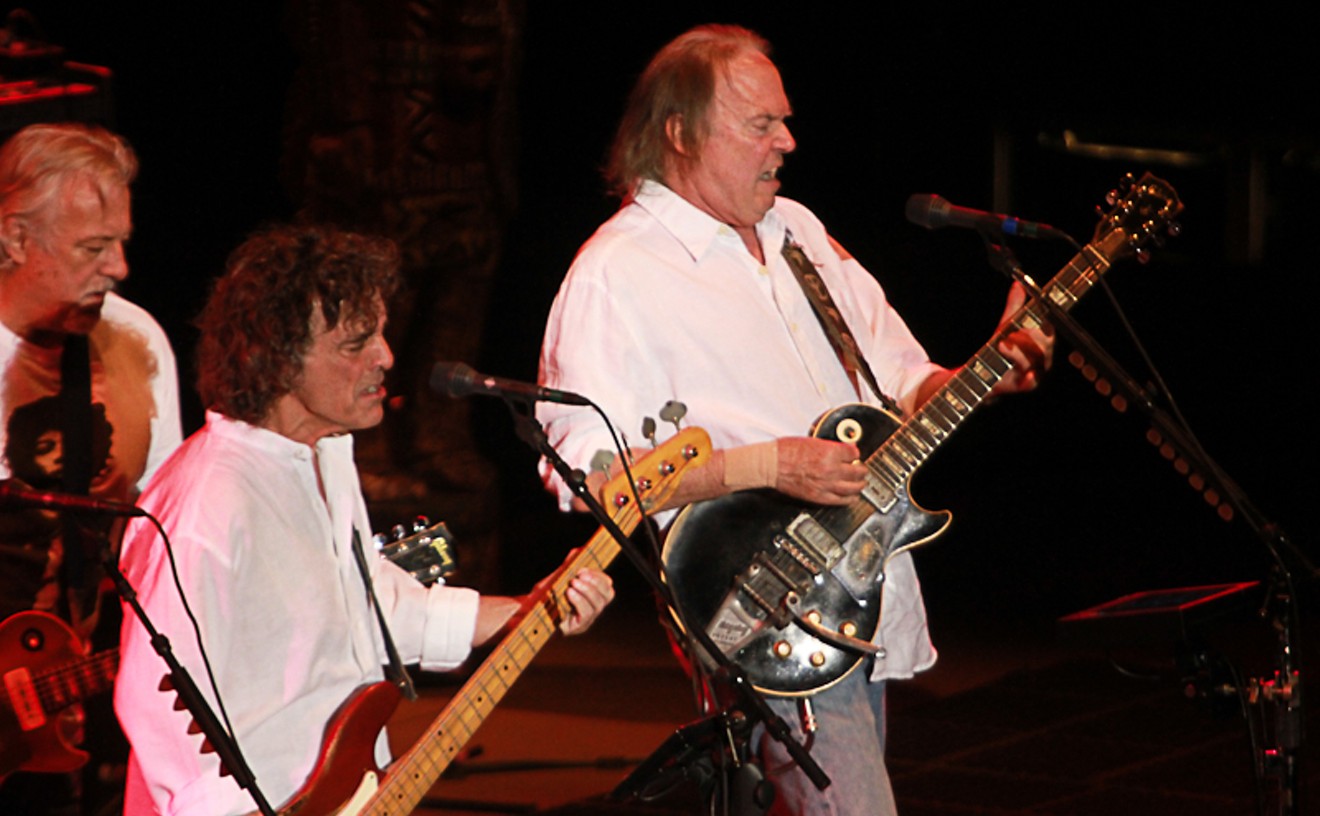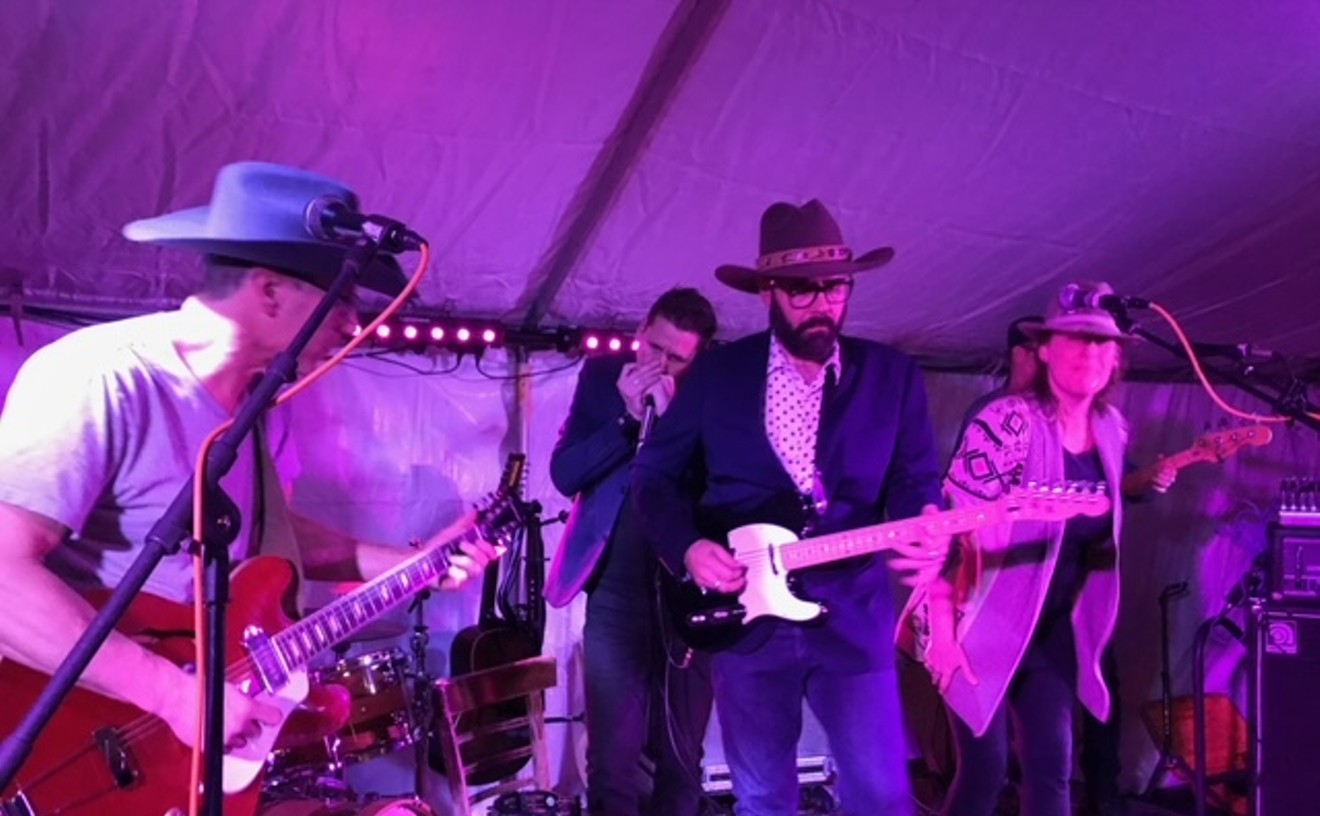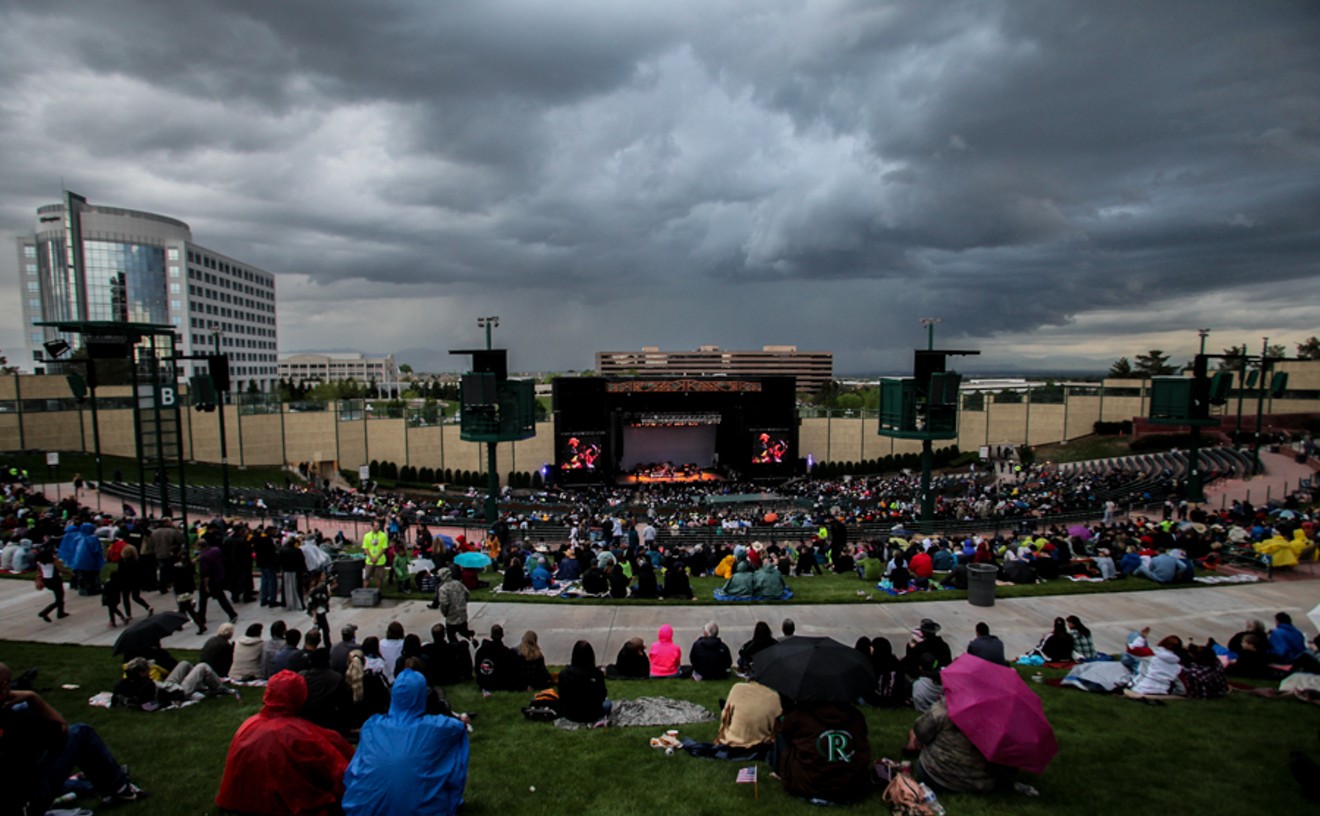In the list below, each year between 1950 and 1999 is twinned with a pop song that says something about the music scene of the period. Many of the selections are artistically wonderful, while some of them, for lack of a better word, aren't. But together they offer some clues about how we as American music fans got from there to here.
"Goodnight Irene"
Written by Huddie Ledbetter and John Lomax
Ledbetter, aka Leadbelly, lived a tough life: In 1918 he was given a thirty-year sentence for murder that was commuted in 1925 after a Texas governor whom he'd begged for mercy in song finally capitulated. His version of "Goodnight Irene" was too ragged for widespread acceptance, but a take by the Weavers, accompanied by Gordon Jenkins and his Orchestra, not only established it as a standard, but fueled a folk boom that would continue well into the Sixties.
"Rocket 88"
Written by Ike Turner and Jackie Brenston
Just how much vocalist Brenston had to do with "Rocket 88" is a matter of debate, especially among Turner supporters. Nevertheless, the significance of the song is undisputed. It was written for the rhythm-and-blues audience, but it's essentially a rock-and-roll tune--some say the first.
"Glow Worm"
Written by Johnny Mercer and Paul Lincke
Songs like "Rocket 88" were initially dismissed by the music industry as "race music" unsuitable for the pale-faced majority. If African-Americans wanted to be heard, then, they had to jump into the mainstream with both feet. Hence "Glow Worm," an old German song reconfigured by Mercer and popularized by the Mills Brothers, an ultra-mellow-sounding black harmony group.
"(How Much Is That) Doggie in the Window?"
Written by Bob Merrill
Of course, "Glow Worm" was the height of soulfulness compared to many of the other pop songs issued during the early portion of the Eisenhower administration. "Doggie," sung with childlike mousiness by Patti Page and interspersed with disembodied ruff-ruffs, was as good an argument as any for the rise of rock.
"Rock Around the Clock"
Written by Max C. Freedman and Jimmy De Knight
Bill Haley and the Comets recorded "Rock Around the Clock" in April 1954, but it didn't become a nationwide sensation until the following year, when it was played over the opening credits of Blackboard Jungle, a muckraking picture about out-of-control high-schoolers. The response of kids in the theaters to this musical explosion served notice that the times were about to change.
"Baby, Let's Play House"
Written by Arthur Gunter
Elvis Presley wouldn't score his first Billboard pop blockbuster until 1956, when "Heartbreak Hotel" first hung out its shingle. But "Baby, Let's Play House" made an impact in the country market via one of Presley's wildest performances. His vocal stuttering ("Buh-buh-buh-buh-buh-buh-baby"), the unstoppable rhythms and Gunter's mildly lascivious words are playful indeed. Grownups might not have gotten it, but the little girls understood.
"Why Do Fools Fall in Love"
Written by Frankie Lymon and George Goldner
The Presley blitzkrieg, which struck full force in 1956, set off a youthquake that shook up the music biz like never before. Suddenly, someone as young and black as Lymon, whose group was called the Teenagers, could become a heartthrob for young women of any skin color. No wonder the Klan was worried.
"Rock & Roll Music"
Written by Chuck Berry
Prior to 1950, few popular performers wrote their own material; rather, they selected it from the inventories of professional tunesmiths--and sometimes received a bogus songwriting credit for doing so. But with big labels ill-prepared to capitalize on rock, singer-songwriters got an opportunity to perform numbers they'd created themselves. Of the early rock scribes, none was better than Berry.
"Fever"
Written by John Davenport and Eddie Cooley
Musicologists know that "Fever" was actually written in 1956 and first performed by blues singer Davenport, aka Little Willie John. But the success two years later of the rendition by Peggy Lee, a performer who first came to fame during the pre-rock era, showed her peers that joining rockers made a lot more sense than trying to beat them.
"What'd I Say"
Written by Ray Charles
Gospel is every bit as key to the African-American musical tradition as blues, yet there was always a stigma against using a style associated with worship and religion in a secular context. With "What'd I Say" and several of his other compositions, Ray Charles shattered this notion for all time, adding gospel's call-and-response vocals to the pop/soul vocabulary.
"Take Five"
Written by Paul Desmond
Jazz began as dance music, but as the music became more challenging and esoteric, the fan base slowly, sadly started to shrink. The divorce between pop and jazz was never total, however, and on occasion, artists with the right temperaments were able to bridge the genres. With the Top 40 hit "Take Five," Dave Brubeck, a structuralist from the cool school, was able to do just that.
"Hello Walls"
Written by Willie Nelson
A hit for C&W singer Faron Young, "Hello Walls" was an indication that country music wasn't necessarily the simple-minded stuff that its uninformed critics assumed. The psychologically complex lyric by Nelson, who was still years away from stardom as a performer, showed that the form was growing up.
"Moon River"
Written by Johnny Mercer and Henry Mancini
When Elvis entered the Army in 1958, much of the momentum went out of rock, and by the time he'd returned, music moguls had figured out how to produce denatured, more controllable variations on him (e.g., Fabian). This damaged rock just enough to give more traditional artists an opportunity to be heard again. "Moon River," a swoony Breakfast at Tiffany's soundtrack item that appeared in late 1961 and spent half of the next year on the charts, exemplifies the phenomenon.
"Be My Baby"
Written by Jeff Barry, Ellie Greenwich and
Phil Spector
The concept behind song factories like the Brill Building seems antithetical to rock, but artists such as Phil Spector were able to pull great music out of them anyway. "Be My Baby," with its massive drumbeat intro and emblematic Wall of Sound production, helped compensate for the dullness of much early-Sixties pop.
"I Want to Hold Your Hand"
Written by John Lennon and Paul McCartney
The harbinger of the British invasion, "I Want to Hold Your Hand" is in many ways a modest little ditty. Under closer analysis, though, the song is overflowing with pop verities--a strong idea, big hooks--and George Martin's crystalline production, which efficiently spotlighted the Beatles' dynamic performance, caused it to leap out of radios everywhere. In the years to come, the band would effect movements as diverse as power pop, art rock and psychedelia. All roads lead back to the Beatles.
"Like a Rolling Stone"
Written by Bob Dylan
Coming mere months after Bob Dylan went electric on the album Bringing It All Back Home, "Like a Rolling Stone" broke ground in several areas: its length (over six minutes), its sound (folk-rock), its idiosyncrasies (dig that atonal harmonica) and its unparalleled complexity (its metaphors are endlessly fascinating). It might be the most meaningful single of the rock era.
"Good Vibrations"
Written by Mike Love and Brian Wilson
Only in retrospect was it obvious how far out Brian Wilson was in 1966. That year, his band, the Beach Boys, came out with Pet Sounds, whose songs--including "Wouldn't It Be Nice" and "God Only Knows"--prefigure today's indie pop. "Good Vibrations," for its part, was as sunny as Wilson's previous beach tributes, but its arrangement, complete with a wiggly theremin, was an indication that pop music was about to get even weirder.
"Purple Haze"
Written by Jimi Hendrix
Prior to the mid-Sixties, rock guitar was a more or less rudimentary tool. But Hendrix showed that the guitar could be used impressionistically, as a sonic brush painting in the colors of beauty, anger and everything in between. Hendrix was also a fine songwriter and singer--a part of the equation that too many guitar gods who came after him chose to ignore.
"Think"
Written by Aretha Franklin and Ted White
As rock was splintering into myriad pieces, soul was hitting one of its periodic peaks--and Aretha Franklin was one of many fine performers standing on the summit. The songs in her library are informed by gospel, but they don't argue in favor of turning the other cheek. "Think" is about standing tall as an African-American and as a woman, giving it an added resonance to members of both groups.
"Gimme Shelter"
Written by Mick Jagger and Keith Richards
The Rolling Stones made a lot of terrific music prior to this year, including "(I Can't Get No) Satisfaction." But during the late Sixties, the group began exploring murkier regions, infusing its work with a danger that was extremely compelling and notably prescient. Songs like "Gimme Shelter" seemed to argue that the hippie era wouldn't last much longer.
"Paranoid"
Written by Geezer Butler, Tony Iommi,
Ozzy Osbourne and Bill Ward
As Woodstock turned into Kent State, Black Sabbath was cranking up guitar riffs bigger and uglier than any previously heard. Plenty of reviewers back in the day hated stuff like "Paranoid," declaring it to be a creative dead end, but they couldn't have been farther off. The sound has been claimed as a major inspiration by musicians
into heavy metal, punk and grunge.
"Stairway to Heaven"
Written by Robert Plant and Jimmy Page
Whereas Black Sabbath stuck to the dark side, Led Zeppelin found a way to navigate between that region and more ethereal places. "Stairway to Heaven," which moves from delicate picking and flighty poetry to cock-rock wailing and slabs o' guitar, might be the most overplayed rock song ever, but that's only because it strikes so deep a chord.
"Superstition"
Written by Stevie Wonder
During the early Seventies, R&B, soul and funk mirrored the dissatisfaction felt by African-Americans victimized by racism, poverty and uncounted social ills. "Superstition" may not be about a topical issue, but it bristles with the intensity that can be heard in the work of acts as disparate as Curtis Mayfield and Funkadelic.
"Walk on the Wild Side"
Written by Lou Reed
When Brian Eno said that the handful of people who bought the Velvet Underground's first record all started bands, he probably thought he was exaggerating. But the influence of Lou Reed on the evolution of glam, new wave, no wave and punk is immeasurable, if only because he showed that nothing is off-limits--not even talking about giving head in a hit single like this one.
"Free Man in Paris"
Written by Joni Mitchell
From a commercial standpoint, the early Seventies was a time when singer-songwriters ruled. But whereas many of them seemed to feel that the only things they needed to offer to their fans were a few basic strums on their acoustic guitar and a gusher of sensitivity, Joni Mitchell provided more--much more. She's the godmother of today's Lilith Fair performers; now if only her spawn would start taking the kind of artistic risks that drew them to Mitchell in the first place.
"Born to Run"
Written by Bruce Springsteen
Bruce Springsteen was just what the Seventies needed--a rock star who knew the music's history but wasn't hamstrung by it. The words to "Born to Run" are ornate but optimistic, giving the urban experience a splash of greaser poetry, and the music was Phil Spector big without teetering into bombast. Within weeks of the song's release, Brooooce became a role model for an entire generation of music lovers and performers--and he still hasn't betrayed their loyalty.
"Anarchy in the U.K."
Written by Paul Cook, Steve Jones, Glen Matlock
and Johnny Rotten
This song was a stiff in the States, but its monolithic attack and the frenzied nihilism of its lyrics ("I am an anti-Christ/I am an anti-Christ/Don't know what I want/But I know how to get it") made an impact well beyond its sales figures. The punk movement in England (powered in part by a tour starring the Ramones) influenced plenty of Americans, planting a seed that has been growing in one form or another ever since.
"Go Your Own Way"
Written by Lindsey Buckingham
Fleetwood Mac established the California sound of the Seventies, a slick merger of pop and folk rock that simultaneously seemed personal and machine-tooled. Guitarist/vocalist Buckingham (who was considerably better-adjusted than his musical hero, Brian Wilson) deserves most of the credit for achieving this neat trick on "Go Your Own Way" and many of his other songs.
"Stayin' Alive"
Written by Barry, Maurice and Robin Gibb
Disco didn't spring to life because of Saturday Night Fever; Donna Summer's fake orgasms on "Love to Love You Baby" had scandalized the parents of America a couple of years earlier. Still, the pop smarts of the Bee Gees, who'd been dubbed the Australian Beatles back in the Sixties, caused the craze to detonate across the country. People soon grew to hate this fad, but disco's recent return proves there was something to it all along.
"My Sharona"
Written by Berton Averre and Doug Feiger
To put it mildly, the Knack was overhyped: Introduced as the next Fab Four, the band turned out to have just one great song. But "My Sharona" was enough of a smash that radio-station staffers decided to take chances on other groups of its type--and because that definition was ridiculously broad, everyone from power-poppers like the Romantics to punks like the Clash was given a fresh hearing.
"I Will Follow"
Written by Bono, Adam Clayton, the Edge
and Larry Mullen Jr.
U2 may have ridden in on new wave, but this young Irish group actually had more in common with the Who and other classic rock combos unafraid of ringing guitars, oversized gestures and epic statements. As such, the band was an exciting alternative to the manufactured sound endemic in the major-label universe at the time.
"Keep on Loving You"
Written by Kevin Cronin
Unfortunately, there weren't nearly enough U2s, and far too many REO Speedwagons. The term "corporate rock" wasn't invented specifically for "Keep on Loving You," but it fit it perfectly. While great music was being made on the fringes of the pop mainstream, the hegemony of banal acts pushed by business powerhouses kept much of it from being widely heard.
"The Message"
Written by Chase, Fletcher, Glover and Robinson
Hip-hop began making its first mainstream statements in the late Seventies, when the Sugarhill Gang pushed "Rapper's Delight" onto the airwaves. But "The Message," by Grandmaster Flash and the Furious Five, showed that the style was more than just party music. A furious diatribe about inner-city despair, this saga has been called the single most influential song in rap--and it's hard to argue.
"Billie Jean"
Written by Michael Jackson
MTV--Music Television--shaped the music of the Eighties in ways that no single artist could. But in the beginning, the cable channel maintained a strict, albeit undeclared, color line. "Billie Jean," off of Jackson's monumental blockbuster Thriller, was the first song to tear through this barrier, setting the stage for wider dissemination of hip-hop and R&B.
"When Doves Cry"
Written by Prince
With its eerily minimalist funk groove, "Doves" was one of the flat-out strangest chart-toppers of its day. But Prince's autobiographical curveball also served as a guide to an entirely new way of making rhythm-and-blues-oriented music. Because the sound was so distinctive, it became the most widely imitated R&B style of the decade.
"Material Girl"
Written by Peter Brown and Robert Rans
Madonna Ciccone didn't write "Material Girl," but it fit her so perfectly that she might as well have. The song's take-charge attitude mashed together feminism and femininity so daringly that neither ERA supporters nor makeup-loving fluff queens knew for certain whose side Madonna was on. Such contradictions explain why she's still so interesting all these years later.
"Walk This Way"
Written by Steven Tyler and Joe Perry
At a time when rap and rock were seen as diametric opposites, "Walk This Way," a fiery rearrangement of a Seventies-vintage Aerosmith rocker by Run D.M.C., was an act of musical detente. The decision by Tyler and Perry to help hip-hoppers rip into their legacy didn't lead to much copycatting at first, but in retrospect, it was a small step in a promising direction.
"The One I Love"
Written by Bill Berry, Peter Buck, Mike Mills and Michael Stipe
During the Eighties, college radio became a way for musicians who were unable to gain a foothold on the commercial airwaves to get themselves heard. R.E.M. was the poster child for this alternative approach, and with "Love," the combo's first legitimate hit, the musicians let others know that the path could eventually lead to stardom.
"Fuck Tha Police"
Written by O'Shea Jackson, Lorenzo Patterson and Andre Young
By the late Eighties, the poverty and degradation that had led to "The Message" were, if anything, more deeply entrenched than ever. Enter N.W.A., a cadre of gifted young men such as Jackson (Ice Cube), Patterson (MC Ren) and Young (Dr. Dre) who embroidered on what they saw going on around them with an unblinking sense of rage. The upshot was gangsta rap, probably the most controversial musical movement of the past twenty years.
"Head Like a Hole"
Written by Trent Reznor
Electronic sounds had been showing up in pop music for years when "Head Like a Hole" appeared, but in the mainstream, at least, they were used mainly for their metronomic danceability. But Nine Inch Nails, Trent Reznor's one-man band, funneled the electro-belligerence of important precursors such as Ministry into a rock-friendly structure that appealed to hard-rockers previously allergic to machine music. The result was the commercial breakthrough of the industrial style and bands such as Marilyn Manson.
"Vision of Love"
Written by Mariah Carey and Ben Margulies
No matter what kind of music bubbles to the fore, there's always a market for divas--female singers who use rafter-rattling ballads and mid-tempo seducers as platforms for their incredible pipes. Whitney Houston became the preeminent belter of the Eighties, and Mariah Carey joined her with "Vision of Love," the first of a startling eight number-one hits over the next three years. Such songs have been a constant in American music, and the success of Celine Dion's "My Heart Will Go On," from 1997, suggests that's not about to change.
"The Thunder Rolls"
Written by Garth Brooks and Pat Alger
Over the years, a number of C&W artists have scored hits on the pop charts. But Garth Brooks, whose brand of country sometimes sports a rock feel but never quite makes the leap to country rock, went well beyond these achievements. The sales of "Thunder" and other singles from his No Fences blockbuster rivaled or surpassed the totals rung up by his pop peers, lifting the genre as a whole to an unprecedented level of popularity. For better or worse, Brooks is the reason today's country sounds the way it does.
"Smells Like Teen Spirit"
Written by Kurt Cobain and Nirvana
"Teen Spirit," issued in December 1991, is a complex song made up of equal parts songwriting craft, punk energy, metallic fury and youthful confusion. But it works because all of these elements are fused into a single, unavoidable juggernaut that made an immediate and indelible impact on listeners of the time. Its success spawned an entire subgenre, known by the dopey descriptive "grunge," and turned the rock world upside down for two thrilling years.
"Nuthin' but a 'G' Thang"
Written by Snoop Doggy Dogg
When N.W.A. first entered the scene, it seemed absurd to think that gangsta rap could ever make a splash in anything other than the pop backwaters. Wrong. Producer extraordinaire Dr. Dre, with the help of then-unknown Snoop Doggy Dogg, demonstrated that tales of drinking, drugs, womanizing and ghetto gangbanging could be shaped into hit singles. Of such discoveries are revolutions made.
"Sabotage"
Written by the Beastie Boys
A considerable percentage of the suburban pop-music audience resisted the rise of rap, leading to as wide and nasty a musical schism between whites and blacks as any since the rise of disco. Fortunately, a handful of open-eared acts--including the Beastie Boys, who'd long since moved beyond their novelty origins--found a way to incorporate hip-hop elements into a more rock-based sound. Like "Walk This Way," "Sabotage" pointed the way to a music that brought warring parties together.
"Hold My Hand"
Written by Mark Bryan, Jim Sonefeld, Dean Felber and Darius Rucker
The decline of grunge led to a predictable retrenchment, with the music-listening public eager to hear songs that didn't churn up so much angst or require a great deal of thought. Hootie & the Blowfish's first and biggest hit stands in for an avalanche of songs that countered scary and aggressive sounds with a reassuring, if disturbingly bland, musical conservatism.
"Where It's At"
Written by Beck Hanson
Beck may be a collagist at heart, but he doesn't disrespect the styles of music he patches together. Instead, he lifts genres out of their comfort zones and matches them up with unfamiliar partners to create new configurations. That sounds overly theoretical, but thanks to the shaggy sound conceived by Beck and his collaborating producers, the Dust Brothers, "Where It's At" is simultaneously smart and danceable--a blend that more and more indie acts have been trying to achieve.
"Block Rockin' Beats"
Written by Tom Rowlands, Ed Simons and Jesse B. Weaver Jr.
Seldom has a trend been as blatantly manufactured as was electronica. But while the music industry didn't succeed in producing a raft of new techno stars, it managed by accident to focus attention on a legitimately compelling style. With "Block Rockin' Beats" (featuring a sample by Weaver, aka Schooly D), the Chemical Brothers accelerated this process by showing that it was possible to package modern dance music in tasty, bite-sized nuggets.
"Doo Wop (That Thing)"
Written by Lauryn Hill
"Doo Wop," the first solo hit by Lauryn Hill, who made her name with the Fugees, is a diverting tune. But the song is noteworthy because it was one of the first in hip-hop's considerable span to maintain high quality while appealing to a demographic that had previously seemed immune to the style's charms. It's not a sellout, but a canny hybrid whose Grammy win represents a broader victory.
"Livin' la Vida Loca"
Written by Desmond Child and R. Rosa
There's no question that "Livin' la Vida Loca," an exercise in lusty Spanglish belted out with goofy brio by former Menudo hunk Ricky Martin, is a watered-down version of Latin pop. After all, it was co-written by Desmond Child, who once fronted a late-Seventies white-soul act called Desmond Child and Rouge. But this rather silly song has the potential to open doors for far more interesting Spanish-language performers. What, if anything, that will mean for the music of the next millennium won't be known for a while yet. But it should be worth our time to find out.











